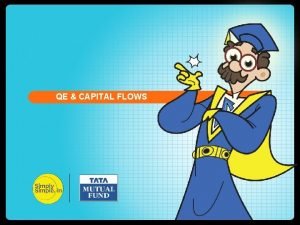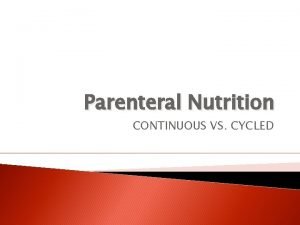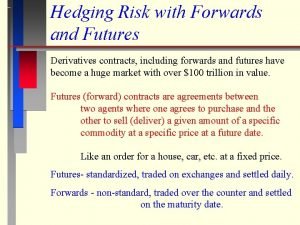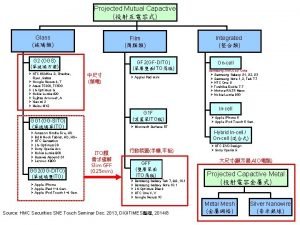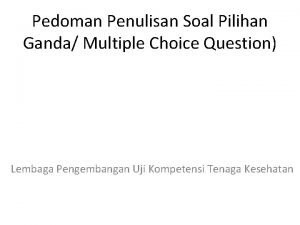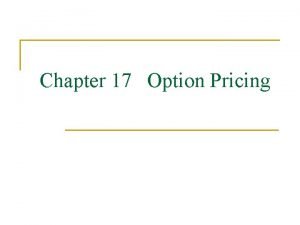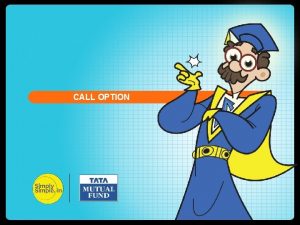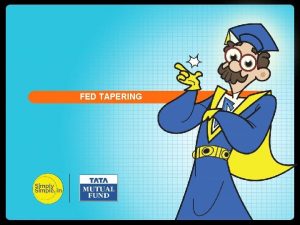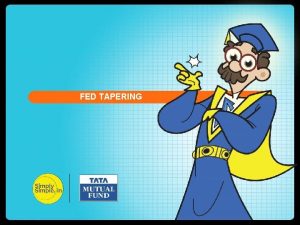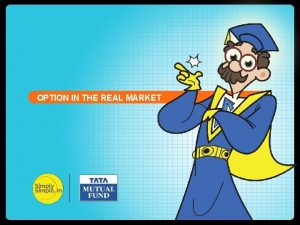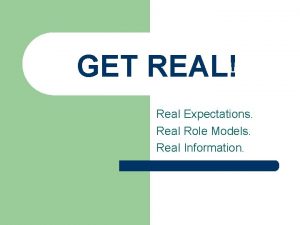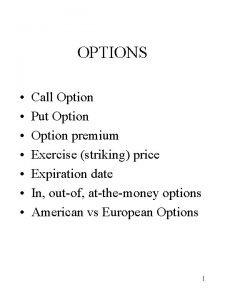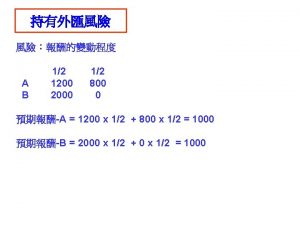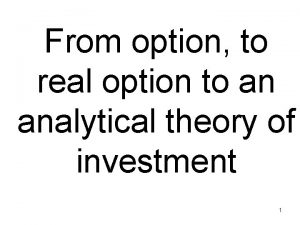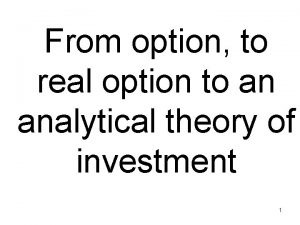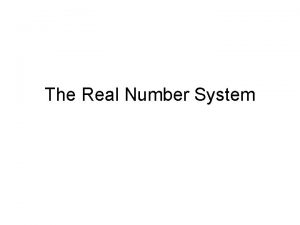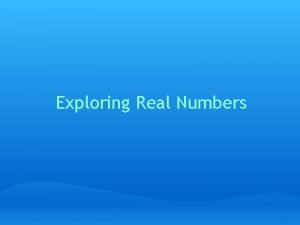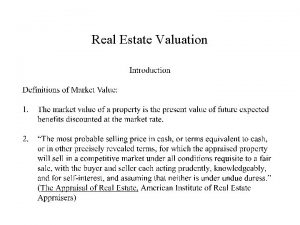FEDMARKET TAPERING OPTION IN THE REAL PUT OPTION

























- Slides: 25

FEDMARKET TAPERING OPTION IN THE REAL – PUT OPTION

Understanding how a typical Option Deal is done in the market – Put Option – By Prof. Simply Simple TM

OPTION IN THE REAL MARKET – PUT OPTION In the stock market there are several participants who are both buyers and sellers…

OPTION IN THE REAL MARKET – PUT OPTION A stock market is a platform where this is free flow of information…

OPTION IN THE REAL MARKET – PUT OPTION This is so that the current stock price is known to every participant (buyers and sellers) Any participant trying to extract a higher price will not be able to do so because of the free flow of information which prevents any sort of price arbitrage. This is what we call ‘Price Discovery’.

OPTION IN THE REAL MARKET – PUT OPTION Now lets say there is a stock option on stock A, which is currently quoting at Rs. 100. And let’s say the option expires after 5 days…

OPTION IN THE REAL MARKET – PUT OPTION Now let’s say there are two participants “Ram” & “Shyam” in this market. Ram is of the view that the stock prices would fall to Rs. 80 in the near future. But Ram does not want to take a risk (i. e. in case the price rises to Rs 120).

OPTION IN THE REAL MARKET – PUT OPTION Hence he chooses to ‘buy’ a put option which protects him against any rise in price. For getting this service, he would have to pay a premium to the seller of the option. The seller of the option, Shyam, on the other hand has a view that the price of the stock will rise.

OPTION IN THE REAL MARKET – PUT OPTION But what if the contract gives Ram the “option” of (either) § Selling the stock to Shyam at the pre-agreed price of Rs 100 (or) § Choosing to exit the contract In other words, Ram is given the option of not honoring the contract made with Shyam on the date of settlement.

OPTION IN THE REAL MARKET – PUT OPTION Such a contract is called a Futures contract.

OPTION IN THE REAL MARKET – PUT OPTION In a Futures contract both parties are obliged to honor the contract and there is no escape route for either party

OPTION IN THE REAL MARKET – PUT OPTION Such a contract which gives the farmer the option of either executing the contract or exiting it is known as an “Options” contract But the farmer obviously cannot get this privilege just like that. He obviously has to pay a premium for exercising this facility

OPTION IN THE REAL MARKET – PUT OPTION Now, let’s say that after 3 months the price of wheat reaches Rs. 120 In this case the farmer quite obviously will want to exit the contract so that he is free to sell his produce in the open market for Rs. 120. Thus while the farmer gets away the bread manufacturer is left high and dry and has no other option but to buy from the open market at Rs 120

OPTION IN THE REAL MARKET – PUT OPTION But it is not such a bad situation for the bread manufacturer as it appears as he gets compensated by the farmer for having been a party to the “Options” contract. This compensation * in the form of price is called the “Option premium” that the farmer has to pay for the Options contract and quite evidently it would be a small amount. Let’s say in our case the amount is Rs 2. So the farmer is obliged to pay the bread manufacturer Rs 2 as he has chosen to opt out of the contract.

OPTION IN THE REAL MARKET – PUT OPTION Thus although the bread manufacturer has no other option left but to go to the open market and purchase wheat at Rs. 120, he does get the benefit of Rs 2 as compensation for being a party to the “Options” contract. So even if the price is Rs. 120 in the open market, for him the effective price turns out to be Rs. (120 -2) = Rs 118. So by simply participating in the contract he too stands togain something

OPTION IN THE REAL MARKET – PUT OPTION As far as the farmer is concerned it is a win – win scenario for him by participating in the contract. Had the prices fallen to Rs 90 as he had anticipated he would have executed the Options contract. But since prices rose to Rs 120 he chose to exit the contract. Thus he is blessed with the “Option” by signing such a contract.

OPTION IN THE REAL MARKET – PUT OPTION It is important to understand that in an “Options” contract only one party gets the privilege to exercise the option while the other party is obliged to honor the option chosen. Thus in our case the farmer has the option to either execute or exit the contract whereas the bread manufacturer is obliged to honor the decision of the farmer. A contract such as this where only the seller of the commodity gets the option to either exercise or exit the contract is known as “Put” option.

OPTION IN THE REAL MARKET – PUT OPTION There is another option which is called a “Call” option

OPTION IN THE REAL MARKET – PUT OPTION q Even in an Options contract both parties land up achieving their goals and their interest is protected q The farmer stands to gain the most by getting to exercise a choice that benefits him the most q The bread manufacturer too benefits by being a party to the contract due to the compensation he receives from the farmer for not honoring the contract.

OPTION IN THE REAL MARKET – PUT OPTION q The bread manufacturer due to the compensation receives wheat from the open market at an effective price of Rs 118 q And hence is better off than the ordinary or spot buyer who would have to pay Rs 120.

OPTION IN THE REAL MARKET – PUT OPTION Thus in a sense both parties landed up getting some gains by being parties to the “options contract”. However unlike in a “Futures” contract, in the “Options” contract one party gains more than the other party.

OPTION IN THE REAL MARKET – PUT OPTION q I hope I have been able to explain to you what ‘margin money’ is all about. q Do give me your feedback about my lessons so that I can work on them and improve them for your better comprehension.

OPTION IN THE REAL MARKET – PUT OPTION Please do let me know if I have managed to clear this concept for you. Your feedback is very important to me as it helps me plan my future lessons.

Please give your feedback at professor@tataamc. com

DISCLAIMER The views expressed in this lesson are for information purposes only and do not construe to be any investment, legal or taxation advice. The lesson is a conceptual representation and may not include several nuances that are associated and vital. The purpose of this lesson is to clarify the basics of the concept so that readers at large can relate and thereby take more interest in the product / concept. In a nutshell, Professor Simply Simple lessons should be seen from the perspective of it being a primer on financial concepts. The contents are topical in nature and held true at the time of creation of the lesson. This is not indicative of future market trends, nor is Tata Asset Management Ltd. attempting to predict the same. Reprinting any part of this material will be at your own risk. Tata Asset Management Ltd. will not be liable for the consequences of such action. Mutual Fund investments are subject to market risks, read all scheme related documents carefully.
 Tapering qe
Tapering qe Tpn cycling
Tpn cycling Forward hedging
Forward hedging Tapering fed
Tapering fed Bur
Bur Vignette multiple choice
Vignette multiple choice Long call short call
Long call short call Put option formula
Put option formula Put out the light
Put out the light Put your right foot in put your right foot out
Put your right foot in put your right foot out Phép trừ bù
Phép trừ bù Hát lên người ơi alleluia
Hát lên người ơi alleluia Lời thề hippocrates
Lời thề hippocrates Sự nuôi và dạy con của hổ
Sự nuôi và dạy con của hổ đại từ thay thế
đại từ thay thế Vẽ hình chiếu vuông góc của vật thể sau
Vẽ hình chiếu vuông góc của vật thể sau Quá trình desamine hóa có thể tạo ra
Quá trình desamine hóa có thể tạo ra Công thức tiính động năng
Công thức tiính động năng Thế nào là mạng điện lắp đặt kiểu nổi
Thế nào là mạng điện lắp đặt kiểu nổi Dạng đột biến một nhiễm là
Dạng đột biến một nhiễm là Bổ thể
Bổ thể Vẽ hình chiếu đứng bằng cạnh của vật thể
Vẽ hình chiếu đứng bằng cạnh của vật thể độ dài liên kết
độ dài liên kết Các môn thể thao bắt đầu bằng tiếng đua
Các môn thể thao bắt đầu bằng tiếng đua Sự nuôi và dạy con của hươu
Sự nuôi và dạy con của hươu điện thế nghỉ
điện thế nghỉ
